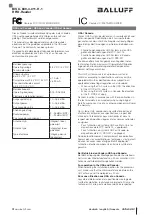
National Instruments Corporation
5-1
DAQCard E Series User Manual
Calibration
Chapter
5
This chapter discusses the calibration procedures for your
DAQCard E Series card. If you are using the NI-DAQ device driver,
that software includes calibration functions for performing all of the
steps in the calibration process.
Calibration refers to the process of minimizing measurement and output
voltage errors by making small circuit adjustments. On the DAQCards,
these adjustments take the form of writing values to onboard calibration
DACs (CalDACs).
Some form of DAQCard calibration is required for all but the most
forgiving applications. If no DAQCard calibration were performed,
your signals and measurements could have very large offset, gain, and
linearity errors.
Three levels of calibration are available to you, and these are described
in this chapter. The first level is the fastest, easiest, and least accurate,
whereas the last level is the slowest, most difficult, and most accurate.
Loading Calibration Constants
Your DAQCard is factory calibrated before shipment at approximately
25
°
C to the levels indicated in Appendix A,
Specifications
. The
associated calibration constants—the values that were written to the
CalDACs to achieve calibration in the factory—are stored in the
onboard nonvolatile memory (EEPROM). Because the CalDACs have
no memory capability, they do not retain calibration information when
the DAQCard is unpowered. Loading calibration constants refers to the
process of loading the CalDACs with the values stored in the EEPROM.
NI-DAQ software determines when this is necessary and does it
automatically. If you are not using NI-DAQ, you must load these values
yourself.
In the EEPROM there is a user-modifiable calibration area in addition
to the permanent factory calibration area. This means that you can load
This document was created with FrameMaker 4.0.4
















































